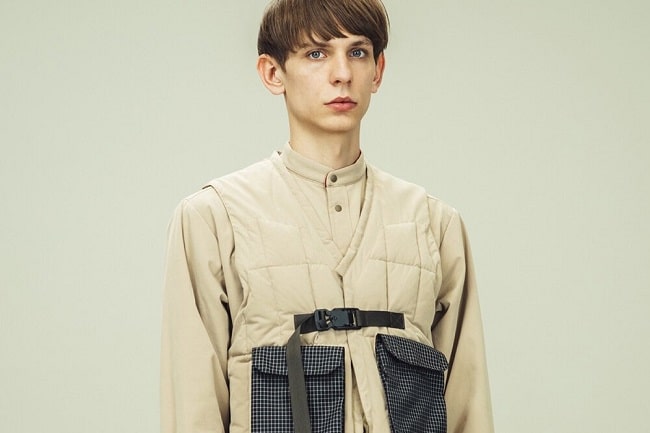1
HOME > Trends >
HOW TO DO THE UTILITY MENSWEAR TREND
Written by Ivan Yaskey in Trends on the 9th March 2021

Over the past few seasons, “utility” has entered the menswear lexicon. It initially applied to field jackets, in a military-alluding olive green. It’s also a remnant of the intersection menswear had with workwear a few years back, and as a progression of this development, classic workwear pieces and their modern counterparts are sought after for their durability, practicality, and, frankly, classically utilitarian nature. But, then gorpcore entered the picture, confusing at first for its exaggerated pragmatism, to the point that the practical with its bevy of pockets suddenly felt impractical and a tad ostentatious. Yet, brands still seem to be in awe of outdoor clothing, both for its utilitarian, no-nonsense construction and for its performance properties. The spawn of this development seems to have taken two roads. On one hand, outdoor-originating brands have started cultivating streetwear-based and luxury collections. On the other, the cargo trouser has returned, perhaps in maximalist form. Whatever perspective you take, utility menswear appears deceptively straightforward – but you can also venture toward overkill with too many pockets and an emphasis on oversize-only fits.
What is Utility Menswear?
“Utility” is nothing and everything at the same time. The moniker can apply to everything practical – neutral or earth hued, where function takes precedence over form. It’s also a buzzword that’s brought out when a garment is covered in pockets. To some extent, most of modern menswear can be considered utilitarian. All you have to do is look back at the military roots of many common garments, from chinos and cardigans to balmoral boots, to get the picture. Through this perspective, modern-day utility menswear shows its military roots, perhaps appearing as if you found it at a surplus shop and upcycled it or, more directly, coloured in a shade of olive or tan to blend in with the surroundings. Yet, military garb historically migrated into everyday style for its ease of wear combined with durability. Building off this notion, utilitarian style ends up being almost synonymous with minimalist menswear. It’s versatile and adaptable, giving multi-season use through its easy-to-layer construction and neutral colours that make this possible. Utility, in this instance, means you’ve pared everything down to the barest basics, using only what gives you the most mileage and is strong enough to handle the distance.

These two angles build off the UK’s Utility Clothing Scheme, created in response to rationing materials during World War II and lasting into the early 1950s. Yet, the garments experienced a brief period of popularity, as consumers discovered their quality and lower-than-average prices. As a third factor, utility romanticises what’s now dubbed heritage workwear – durable leather, denim, and cotton duck, perhaps insulated with flannel, all crafted decades ago to hold up to the rigors of a factory, construction, or industrial job. The clothing and footwear were simple and built for a purpose, while much of modern-day workwear attempts to pass itself off as something it’s not – see work boots styled like sneakers and Dickies’ work jeans as a few examples. Considering this framework, utility menswear casts a wide net. It encompasses bomber jackets based on the MA-1 and field jackets, cargo trousers, classic raw denim, and even T-shirts fabricated to last more than a few washes. You’ll see it exaggerated, with large pockets covering almost every surface, thick soles on combat-style boots, and oversized workwear jackets, and you’ll see where the practical intersects with the fantastical, like a brightly coloured puffer jacket treated to be waterproof. Yet, even when utility style appears maximalist, you sense that everything selected was added for a purpose – not to be beautifully embellished or to make a statement but to exist and provide its wearer with a specific function and role.

The Basics
You likely already have a few classic and workwear items in your wardrobe. Rather than go through everything, the key utility pieces include:
Cargo Trousers: These aren’t the kind you wore back in the late ‘90s and early ‘00s. Today’s cargo trousers aren’t just khakis with extra pockets. Rather, you see the outdoor influence upfront, combined with more of a military attitude. As such, nylon more so than cotton is used, the pockets are larger and more numerous, and there’s also a nod to traditional workwear styles, through zippers or loops on the exterior.
Utility or Field Jacket: Whatever name you want to use, this jacket blends the practical nature of a workwear style, down to the heavier material and multiple exterior pockets, with military origins. This category encompasses everything from a straightforward chore coat, offering spare room for tools on the exterior, to the lighter-weight yet still pocket-covered safari jacket to a classic Carhartt cotton duck jacket to even a flight jacket, with its zippered or flap pockets on the arm.
Utility Vest: While this garment might seem like a lighter-weight version of the utility jacket, it’s essentially a merging of the aesthetics of a photography vest with a military garment offering space and modular capabilities. While you’ll spot them in standard olive and desert tan, you’ll also encounter them in denim and brighter shades, essentially making them the only true statement piece on this list.

How to Attempt Utility Style
If you’re curious about utility style, here’s how you can ease into it:
Begin simple: Start with classic and workwear pieces and pair them with a jacket, vest, or trousers featuring more of a utility design.
Think about colours: Considering the versatile connotations of utility style, you’ll want to stick with neutral shades and earth tones, including brown, olive and other greens, tan, and grey. While you’ll spot utility pieces in reds and other bright hues, understand that their nature and applicability is more fleeting.
Consider camouflage: Camouflage returned a few years ago among streetwear trends. For a more traditional approach, consider a standard camo pattern – a woodland or digital configuration in brown, tan, and green hues – rather than something experimental.

Think about pockets: Yes, extra pockets are practical, but you don’t want to overstuff them. Rather, look at the number on a jacket’s or trousers’ exterior, and acknowledge that while you’ll place items like keys and a wallet inside, you don’t want to feel or look weighed down in excess. As well, don’t add extra pockets from head to toe – relegate them, instead, to a single item.
Examine the fit: More and more garments feature an oversized fit these days. Yet, you don’t want to settle on something too shapeless. While skin-tight and even slim don’t read as the most practical, you can still find some definition with a relaxed or regular cut.
Don’t discount accessories: If a utility jacket or cargo trousers seem too much, dip your toe into the pool with a similarly practical accessory, be it a hiking pack, cross-body bag, boonie hat, or military cap.

Trending
2
3
4
5
6
7
8
9
10










